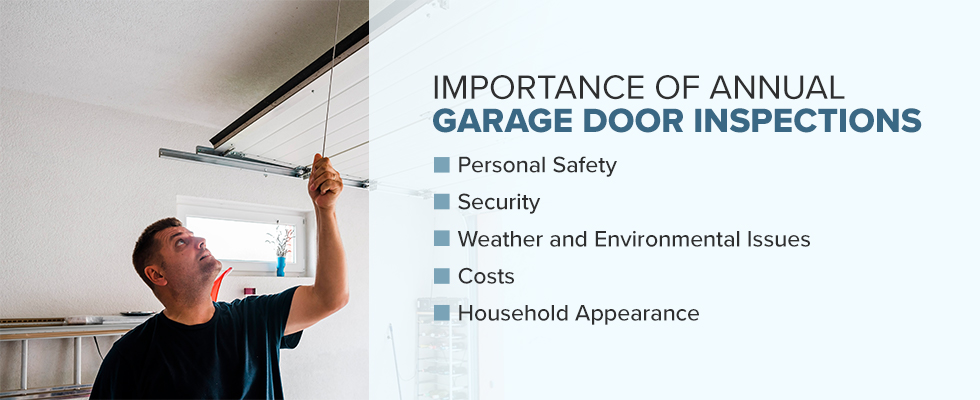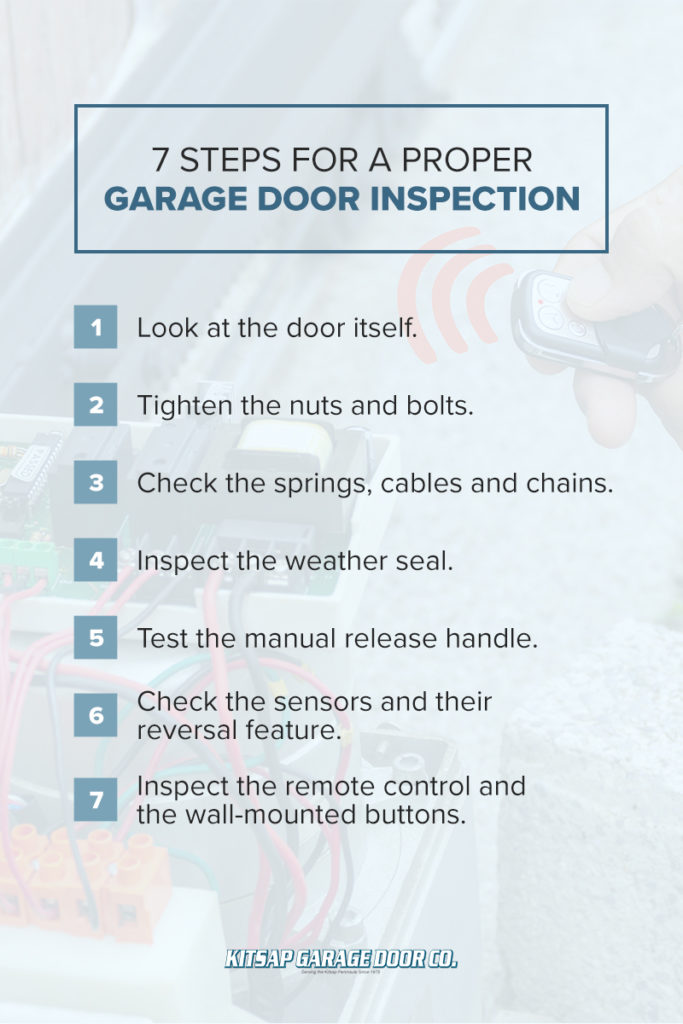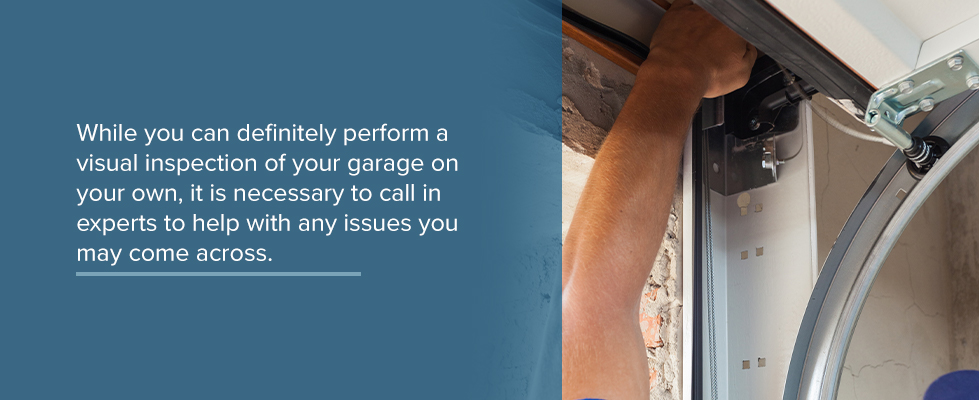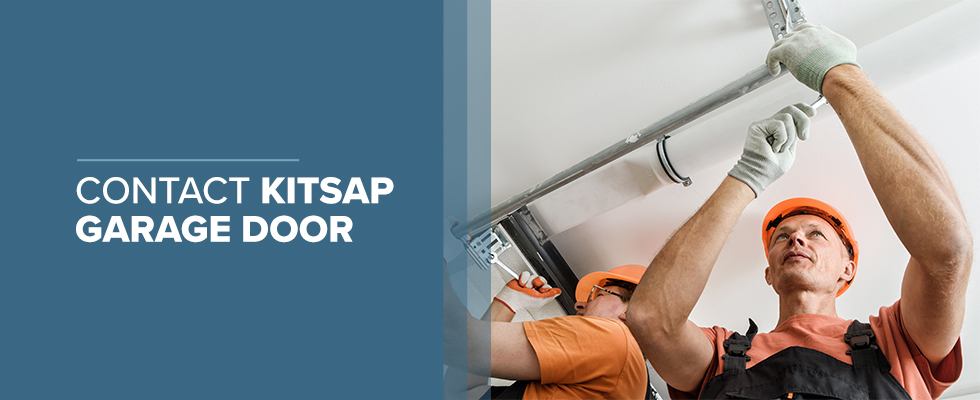Garage Door Inspection Guide
As a homeowner, you probably have a lot of seasonal and annual maintenance checklists you rely on to ensure your home is in its best possible shape. While you may not think about garage door repairs unless you notice an active issue or emergency, your garage door is something you should inspect at least once a year.
Since it’s a main entrance to your home and something you use daily, it is important to be able to rely on the safety and function of your garage door. Considering that your garage holds items valuable to you, like your car and outdoor appliances, functionality and reliability of the garage door are imperative.

Importance of Annual Garage Door Inspections
On average, your garage door will go up and down over a thousand times per year. Garage doors are heavy-duty systems with many moving parts that need annual servicing to keep them working and visually appealing. Because they are such a major part of any home, both functionally and aesthetically, their upkeep is of extreme importance, and many aspects contribute to this importance:
Personal Safety
The main reason you should conduct annual inspections on your garage door is for safety reasons. If you do not properly maintain each working part of your garage door system, you risk door failure, which can result in injury. According to the US Consumer Product Safety Commission, there are around 30,000 injuries caused by garage door accidents yearly.
One garage door function that prevents many injuries is the safety reverse or automatic stopping function of automatic garage doors. However, without proper maintenance, this function can easily malfunction, leading to a preventable accident.
Security
Related to safety, another big reason to perform garage door inspections is that the garage door is a main entrance to your home, and you do not want to make it accessible to just anyone. Unmaintained garage doors are a common point of entry for home burglars. One reason for this is because burglars know that garages often contain expensive equipment, such as cars, outdoor appliances, tools and sporting equipment. Another reason break-ins occur through the garage is that it may be less conspicuous than entering the home through a front door or climbing through a window.
If you properly maintain and visibly secure your garage door, this lessens the chance that a burglar will target your garage. Factors that contribute to garage security include making sure your garage door shuts entirely, keeping track of any remote controls for your door and ensuring that only a secure passcode opens your door.
Weather and Environmental Issues
Another important aspect of checking your garage door yearly is the potential for weather and environmental issues. During the winter, garage doors can easily freeze shut from extreme temperatures. You can prevent this, however, by properly maintaining and lubricating your garage door’s weather seal.
Garage doors that do not work properly also run the risk of allowing pests and unwanted animals into your garage. If you do not have a sealed garage door or if it does not close entirely, you chance invasive or dangerous bugs and animals entering your home. This is especially prevalent in the winter when animals may want to escape the cold. In the warmer months, if you keep plants or bird food in your garage, you run the risk of a hungry animal finding it.
Costs
A lot of monetary factors play into choosing and maintaining a garage door. The initial purchase of your garage door is a big investment, and you want to be sure to maximize the life of your garage door to make it a worthwhile venture. Also, replacing an old garage door and keeping your new one well-maintained can increase the value of your home and give you a significant return on investment.
Keeping your garage up-to-date can help you avoid costly repair bills from unexpected failures. It is cheaper to fix the smaller issue before it worsens and causes other parts of the garage door system to fail. If you are unaware of a problem or avoid fixing something when it first happens, the garage door can either become immobile or it will rely more heavily on other parts within the system, weakening them and causing greater issues. Annual garage door inspections can help you notice anything unusual about your garage door system, and maintaining it properly can add years to its life.
Another cost factor affected by your garage door is your heating and cooling. Your garage may contribute to a higher heating bill in the winter in a few ways. For example, in the United States, the average household spends $960 on heating. When you have the furnace on, it works to make the entire house your desired temperature. If your garage is uninsulated or not properly sealed, this allows the cold from outside to get in on top of the regular heat transfer from shared walls. This forces your heater to work harder and longer so that all parts of your home reach an equal temperature. If you have proper weather seals and an air-tight garage door system, this keeps the warm air in and the cool air out — or vice versa in the summertime — ultimately saving you money.
Household Appearance
Not only does an outdated garage door leave you open to the risks of malfunction or bodily harm, but it also increases the chance that your garage door will look neglected. Without proper care, your garage door may not close properly or completely, can appear worn and can take away from the curb appeal of the home. Annual maintenance helps not only the functionality of your garage, but it also keeps your home cosmetically looking nice and well-maintained.

7 Steps for a Proper Garage Door Inspection
To ensure that the garage door system works properly and is as safe as possible, you need to make sure each aspect of the garage door is up to standard. This includes the seemingly smaller parts of your garage door system, such as your garage door remote, to larger aspects like the door itself, the track it’s on and the opener system.
Each of these individual moving parts makes up the system as a whole, guaranteeing efficiency and safety in its use. However, if one of these parts is old, damaged or worn-out, this puts the entire system at risk. Because of the extreme importance of annual garage door inspections, there are many aspects of your garage door checklist to address each year for a safe and smoothly run garage door system.
1. Look at the door itself.
The first and simplest thing you should do to start off your safety checklist is to look at the overhead door. Check the panels for damage, separation or sagging. Look for signs of weathering and aging, such as cracked or peeled paint. This type of wear and tear is common, but it is still necessary to fix it before it leads to other safety and cosmetic issues. Make sure the door looks like it fits appropriately within its frame and closes easily and level.
2. Tighten the nuts and bolts.
As part of a moving system, the hardware that holds it all together can easily loosen. You will want to tighten all the nuts and bolts that support the roller track, roller and brackets to ensure that your garage door continues to operate smoothly.
3. Check the springs, cables and chains.
The springs, cables and chains keep the garage door suspended and allow the door to open and close gradually without slamming or breaking. Annual inspections allow you to lubricate any moving parts, such as springs, cables, chains and gears, as necessary to prevent grinding, stripping and premature failure.
Specifically, the springs will eventually break because of corrosion, but yearly maintenance will help slow this process down and let you note anything that you may need to have fixed soon. As for the cable, look for broken strands, especially where moisture may get to it near the bottom roller bracket. This cable is under high tension and is a key part of the proper safety and efficiency measures of your garage door.
Although your annual checklist helps you find any problems with your garage door, it is necessary to always consult a professional and schedule any important repairs with them. This is a precaution to avoid harming yourself or further damaging your garage door system by attempting to fix major spring or cable issues on your own.
4. Inspect the weather seal.
Because the weather seal helps protect your garage and home from exposure to the elements, it is key that you make sure all weather seals are intact. They can easily become worn, so make sure they still keep the cold air out and will prevent the door from freezing shut in the winter months.
5. Test the manual release handle.
An important safety and emergency prevention feature of your garage door is the manual release handle. This component acts as a way for you to manually detach the door from its handling system so you can open or close the door without electricity or without using the remote. This is helpful in the case of power outages, broken wall controls or emergency situations where you need to detach the door from its manual operating system.
Safety standards require this manual release to be a fixture of every garage. The handle must be red so it is distinguishable from the rest of the garage. It also should be within arm’s reach and easily accessible so that you can quickly find and use it in case of emergency.
6. Check the sensors and their reversal feature.
Another key safety feature of garage doors is their photoelectric sensors and their reversal feature. The sensors are one of the most important parts of the garage because of the safety they offer garage door users. Every garage door manufactured after 1992, per federal law, must have these sensors.
Located on either side of the garage door, these sensors should attach to the wall no more than six inches off the ground. Their purpose is to stop the closing of the garage door if anything intrudes upon these sensors. If something gets in the way of the sensors, your garage door should automatically stop its descent and should reverse back to the fully open position.
You can test this by starting to close your garage door, then, from a safe distance away, push something in front of the sensors. This should trigger the garage door to open back up, protecting the intruding object from getting crushed by the door. Be sure to clear off any liquid or debris that could cause the system to malfunction, and do not store items where they could interfere with the sensors.
7. Inspect the remote control and the wall-mounted buttons.
Test all remotes and switches you have attached to your garage door. Make sure you can account for all remote controls that operate your garage door so you know who has access to your garage and home at any given time. Also, have a unique passcode on the exterior wall-mounted door opener. Do not make your code something that people can easily guess, and give out your passcode only to people you trust to limit the number of people who can enter your garage.
Make sure that any wall-mounted control, both indoor and outdoor passcode openers, are all at least above five feet from the ground. This keeps children from putting themselves at risk by playing with the buttons and opening and closing the door without supervision.

Hire a Professional For Routine Maintenance
While you can definitely perform a visual inspection of your garage on your own, it is necessary to call in experts to help with any issues you may come across. An at-home inspection allows you to identify any minor issues or possible problems you may run across in the future, but you should always have a professional make any changes to your garage door system.
Because your garage door is a part of a mechanical system with many moving parts, it is important for you to know what parts you need and how they work before you try making any repairs on your own. In any case where an aspect of your garage door needs to be altered, contact a professional skilled worker and get their opinion on how to fix the problem. Avoid any do-it-yourself quick fixes, as this potentially puts yourself and anyone else using the garage door at risk to experience system failure that can cause bodily harm.

Contact Kitsap Garage Door
Since 1975, we at Kitsap Garage Door have reliably and responsibly serviced the Kitsap Peninsula with residential and commercial garage door inspections, repairs, maintenance and installations. We offer home and business owners high-quality products and services to meet all of your garage door needs.
Schedule a garage door service with us by filling out our online schedule service form. If you would like to receive an estimated price for a garage door or if you have any questions, fill out our request an estimate form. Otherwise, if you have any additional questions or comments, call us at 800-649-0849.


